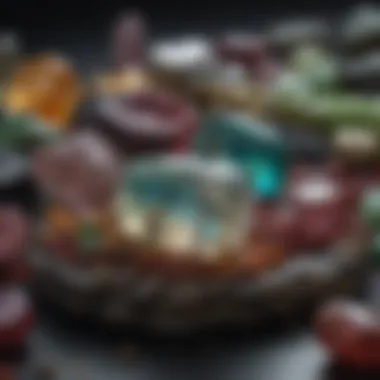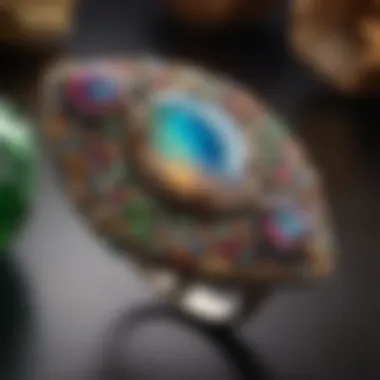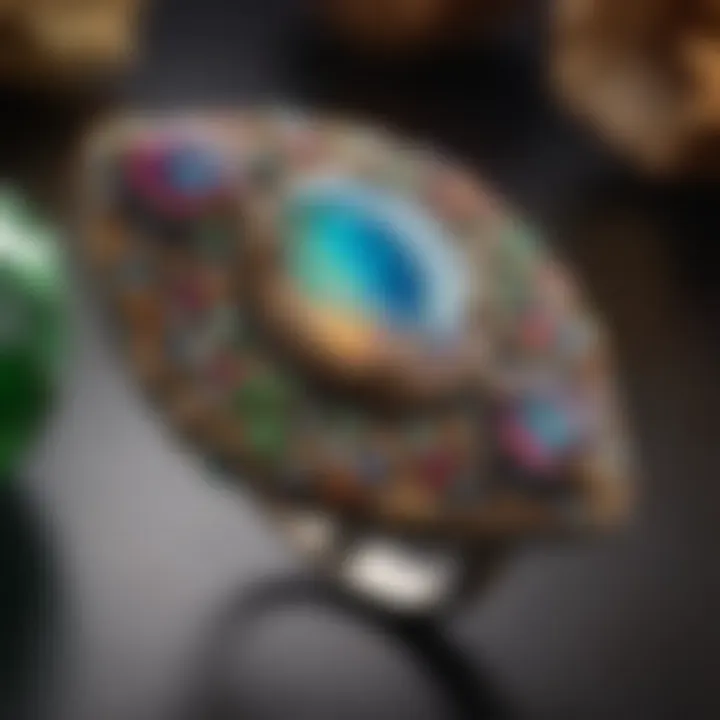The October Birthstone: Opal and Tourmaline Explained


Intro
October brings with it a vibrant tapestry of colors and emotions, capturing the hearts of many. With the transition from warm summer days to the crispness of autumn, there’s more to this month than just pumpkin spice lattes and Halloween decorations. It’s also home to two intriguing gemstones: opal and tourmaline. These stones are not only visually striking, but they also carry a rich history and profound symbolism. As we explore the unique characteristics, historical significance, and cultural implications of these gems, we find that they embody both beauty and meaning in the world of personal adornment.
Gemstone Overview
Definition and Characteristics
Opal and tourmaline are distinguished by their remarkable appearance and diverse properties. Opal, renowned for its play of color, can present an astonishing array of hues, ranging from deep blues to fiery oranges and everything in between. This characteristic, known as opalescence, is a result of silica spheres that create a diffraction of light, resulting in the stunning visual effects that make opals so desirable to jewelry enthusiasts.
On the other hand, tourmaline showcases a spectrum of colors, often within a single stone. This gemstone comes in shades such as pink, green, and even bi-colored variations, like the watermelon tourmaline, which displays both pink and green hues. The piezoelectric properties of tourmaline lend it a unique significance in metaphysical practices, being associated with healing and protection.
Classification of Gemstones
Both opal and tourmaline belong to the class of gemstones known as silicates. This classification speaks to their underlying chemical composition, which comprises silicon and oxygen. However, it’s the specific arrangement of these elements and the presence of trace minerals that set them apart not just from each other but from other gemstones as well.
- Opal:
- Tourmaline:
- Amorphous, meaning it lacks a crystalline structure.
- Composed mainly of silica, with water content ranging from 5% to 10%.
- Crystalline, with a complex boron silicate structure.
- Contains a variety of elements, including aluminum, iron, magnesium, and lithium, allowing for its wide range of colors.
Historical Significance
Ancient Uses and Cultural Importance
Throughout history, both opal and tourmaline have held a special place in various cultures. In ancient Rome, opals were considered a symbol of hope and purity. It was said that those who possessed opals were granted the ability to foresee the future. Similarly, tourmaline has been cherished since ancient times, often referred to as the "gemstone of the people" due to its widespread availability and variety.
In medieval Europe, opals were believed to possess protective qualities, offering its wearer wisdom and preserving the soul’s very essence.
Myths and Legends Surrounding Gemstones
Legends surrounding opal often weave tales of mystical powers. Many cultures believed it to embody the powers of all gemstones combined, making it the ultimate talisman for protection and inspiration. In the East, opals were often linked with royalty, symbolizing fidelity and loyalty.
On the flip side, tourmaline’s legend stretches globally, with various communities attributing special meanings to its colors. For instance, the green tourmaline was regarded as a protector against evil spirits and as a gemstone to enhance psychic abilities.
"Stones cannot give you strength, but they can echo the power that lies within you."
As we continue to unfold the story of opal and tourmaline, we’ll delve further into their uses in jewelry, care recommendations, and the metaphysical implications that resonate with collectors and enthusiasts alike.
Prelims to October Birthstones
October births stones, opal and tourmaline, stands as a bridge between nature's artistry and human expression. These gems, often admired for their beauty, carry historical weight and cultural significance, making them essential subjects of discussion for gemstone enthusiasts and collectors alike. Understanding what these stones represent is not just about their visual appeal, but also their unique stories and the beliefs woven around them. The duality of opal's ethereal display and tourmaline's diverse colors speaks to the multifaceted nature of our existence, and as such, they offer more than mere adornment.
Historical Context
Historically, opal has been surrounded by a veil of mystique and reverence. Ancient civilizations, such as the Greeks and Romans, identified the stone with purity and truth. It was often considered a symbol of hope and creativity. In contrast, the fascinating tale of tourmaline reveals its connection to various cultures across time, being used as a protective amulet in many traditions.
In the Middle Ages, opal was believed to be a guardian for the faithful against misfortune, a belief stemming from its ability to radiate a spectrum of colors. Tourmaline, on the other hand, was revered by many native tribes in South America. They called it "the stone of the rainbow" because of its vibrant color variations, embodying a spirit of connection to both the earth and the cosmos.
"Both opal and tourmaline encapsulate the historical narratives of love and struggle, serving as talismans of their respective eras."
Understanding these backgrounds shapes contemporary interpretations, allowing collectors and jewelry designers to appreciate these gems beyond their aesthetics. Their rich histories provide depth and context, inviting new generations to celebrate the legacies these stones have brought through centuries.
Modern Interpretation
In today's context, opal and tourmaline have transcended their traditional roles, emerging as symbols of personal expression and individuality. Modern gem enthusiasts often choose opal not only for its brilliant play-of-color but for its connection to emotions and creativity. It's common to hear stories of how different opal colors resonate with different feelings—black opal might symbolize strength while white opal is said to enhance clarity and purity of thought.
Similarly, tourmaline enjoys popularity thanks to its incredible palette of colors, with each hue believed to possess distinct qualities. For instance, pink tourmaline may encourage love and compassion, while green tourmaline is thought to foster balance and emotional healing. This diversity aligns beautifully with current trends in personalized jewelry customization, allowing for more intentional selection based on meaningful attributes.
Collectors of modern jewelry often seek these stones for both their aesthetic value and the deeper meanings they carry, forming connections that are personal and profound. Thus, these October birthstones offer not only visual delight but also an invitation to explore the layers of symbolism and emotion embedded within them.
Opal: The First October Birthstone
Opal stands out as a remarkable gemstone that has been capturing hearts for centuries. Its multifaceted nature makes it an intriguing choice for those celebrating October birthdays. In this discussion, we will explore its rich characteristics, vibrant cultural significance, and the unique allure it brings to jewelry designs. By delving into opal's properties, we gain insights into why this gemstone tends to capture interest beyond its physical beauty.
Characteristics of Opal
Color Variations
Opal is renowned for its ability to present a kaleidoscope of colors, showcasing a spectrum that spans soft pastels to bold, vibrant hues. This specific aspect of Color Variations considerably enhances its appeal among gem enthusiasts. People are drawn to the way opals appear to shift colors under different lighting, creating a mesmerizing effect that one can hardly take their eyes off.
For example, a black opal features a striking contrast that makes its colorful play stand out even more. This characteristic has made opal a popular choice for special occasions, particularly when one seeks a distinctive look. The main advantage of choosing an opal for jewelry is its matchless aesthetic appeal, which makes each piece truly unique.


Transparency and Opacity
When discussing Opal, Transparency and Opacity are important characteristics that contribute to its overall aesthetic. Opal can be seen in forms ranging from transparent to opaque. This means that the way light interacts with the stone varies significantly. Clear or semi-transparent opal tends to exhibit brighter colors, enhancing the vividness of the gemstone. In contrast, opaque opals often create a more subdued aura but carry an elegance all their own.
Choosing the right transparency may depend on personal preference. Transparent varieties are generally more sought after due to their brightness, whereas opaque pieces are favored for specific designs where they can add depth to the overall look. Each version has its own charm and suit different styles in jewelry.
Pattern and Play of Color
The Pattern and Play of Color in opals give them an enchanting quality. This distinctive play of color, often referred to as opalescence, creates a shimmering effect that can transform the stone into a living canvas. Various patterns within the stone can appear, from fiery flashes of color to soft, ethereal swirls.
For gemstone collectors and enthusiasts alike, this unique play of color is a defining feature of opal. It serves as a hallmark of its beauty, indicating the opal's quality and uniqueness. Thus, the advantage of opting for opals is that one can possess a deeply personal stone, often linked to specific designs and moods, granting it an emotional connection beyond just aesthetic appeal.
Cultural Significance of Opal
Historical Lore
Diving deeper into the cultural significance of opal reveals a rich tapestry of historical lore. Ancient civilizations held opal in high regard, often associating it with purity and hope. Its dazzling display made it a sought-after gemstone among nobility and aristocrats through the ages. Legends tell of opals possessing the power to foretell the future and bring good fortune to their wearers, a belief that enhances its appeal.
This historical connection adds depth to the understanding of opal, making it not just a stylish accessory but also a piece steeped in tradition and lore. Owning an opal can feel like possessing a fragment of history itself, connecting individuals to the past while remaining fashionable in the present.
Association with Mythology
Opal's link to mythology is equally fascinating. Various myths surround this gemstone from different cultures, often portraying it as a symbol of inspiration and utopia. For example, in ancient Greek mythology, opal was said to be a gift from the gods, imbued with the powers of prophecy. This historic symbolism contributes to the importance of opals today, which are often viewed as lucky charms.
The diverse mythological significance adds an extra layer of fascination for those who appreciate storytelling through gemstones. Integrating such narratives with modern-day embellishments makes opal even more cherished among collectors and jewelry designers.
Modern Symbolism
In contemporary society, opal symbolizes resilience, creativity, and passion. Many believe it embodies a sense of inner strength, allowing individuals to express themselves authentically. This modern interpretation encourages wearing opals not only for their beauty but also as reminders of personal journeys and values.
The versatility of opal as a modern symbol resonates well with today’s emphasis on individuality. Hence, its role goes beyond mere decoration; it becomes an expression of personal identity and life experiences, making it perfect for bespoke jewelry designs.
Opal in Jewelry
Popular Jewelry Styles
Diverse designs showcase opals in modern jewelry, making them a favorite choice among designers and customers alike. Whether featured in rings, necklaces, earrings, or bracelets, opals add an extraordinary flair to any piece. One popular style is to highlight opals in artistic settings, where their colors can shine prominently.
Choosing opal jewelry is often not just about aesthetics but also about finding unique pieces that reflect the wearer's personality. Popular styles incorporate intricate craftsmanship with opals at the center of attention, thus making a statement.
Setting Techniques
The technical aspect of Setting Techniques for opals often involves protecting their delicate nature while ensuring that their beauty is maximized. Many jewelers choose to use protective settings that safeguard the stone from everyday wear and tear. This ensures that the multifaceted play of color remains vibrant and untouched.
Adopting the right setting technique can significantly influence the jewelry's overall experience. An appropriate setting not only looks stunning but validates the durability of opals enough to be worn regularly.
Care and Maintenance Tips
To preserve the beauty of opals, proper Care and Maintenance Tips are essential for any owner. One must avoid exposing opals to harsh chemicals, which can damage their delicate layers. Additionally, gentle cleaning is advisable, preferably with a soft cloth and warm water.
Understanding how to care for opal can extend its life significantly, making it a treasure for generations to come. This aspect is particularly beneficial for those considering opals as heirloom pieces, ensuring they remain beautiful well into the future.
Tourmaline: The Alternative October Birthstone
Tourmaline stands out as an alternative birthstone for October, providing a compelling addition to the narrative that encompasses both opal and its rich history. This gemstone holds immense importance due to its unique variety of colors, energetic properties, and significance across different cultures. The diverse characteristics of tourmaline can easily captivate the attention of gemstone enthusiasts and designers alike, making it not just a substitute but a fully-fledged contender in the realm of October birthstones.
Unique Characteristics of Tourmaline
Color Spectrum Diversity
Tourmaline's color spectrum is an eye-catching feature that sets it apart from many other gemstones. It can present itself in virtually every color of the rainbow, from deep green to bright pink, and even striking blues. This broad range means there's a tourmaline to suit nearly every preference and occasion.
What makes this characteristic beneficial is that it caters to a wide audience, offering customization options that few gemstones can match. The presence of bicolor or tricolor options, like watermelon tourmaline where pink and green naturally occur together, adds to its charm. This variety allows jewelers to create unique pieces that resonate with individual feelings and styles, satisfying both personal taste and the search for something distinct.
Physical and Chemical Properties
The physical structure of tourmaline, with its complex crystal system, plays a significant role in its desirability. It’s generally robust, making it a viable choice for everyday jewelry pieces. For instance, its hardness, which typically ranks between 7 and 7.5 on the Mohs scale, lends itself well to rings and bracelets that are exposed to daily wear.
From a chemical standpoint, the presence of various elements like iron, magnesium, and lithium can influence its colors profoundly. While this diversity attracts jewelers, it also means that discerning buyers need to understand these variations when selecting tourmaline. The unique combination of colors and compositions may bring both advantages and complications, particularly for those who prioritize specific shades or properties in their gemstone choices.
Varieties of Tourmaline
Understanding the different varieties of tourmaline can deeply enrich one’s appreciation for this gem. There are several types, including elbaite, which is the most commonly known, and indicolite, a rare vibrant blue variety. Each type presents distinct attributes and allure.


One significant advantage of recognizing the varieties is it enables collectors to make informed decisions tailored to their interests, preferences or investment potential. Some varieties, like Paraíba tourmaline known for its neon-like colors, can command high prices, thus presenting not just aesthetic value but investment interest as well. However, the multitude of varieties can sometimes overwhelm someone new to the topic, creating a need for careful research.
Tourmaline in Culture
Historical Uses
Historically, tourmaline has been used in various applications across cultures, from talismans to active components in medicinal practices. Ancient Egyptians valued this stone, believing it drew power from the earth as it traveled through the rainbow.
This historical significance enhances its appeal as a gem with depth, connecting modern wearers with generations before. By adorning oneself with tourmaline, individuals become part of a long history of appreciation that transcends time. The drawback is that not all cultures have extensive written records, sometimes leaving gaps in understanding its full historical trajectory.
Symbolism Across Cultures
The symbolism attached to tourmaline is rich and varied. In some cultures, it represents protection and grounding, ideal attributes for people in turbulent times. The idea of it being a bearer of tranquility and healing resonates with many, particularly those seeking not just jewelry, but emotional and spiritual benefits.
However, the symbolism might differ widely among various groups, potentially causing confusion for those vaguely familiar with its meanings. Knowing what tourmaline might symbolize in one culture might not apply to another. It’s important for buyers to do their homework for clarity.
Modern Relevance
In today’s context, tourmaline remains relevant as it finds its way into modern jewelry, wellness items, and even technology. Its reputation for balancing energy is being embraced more and more, particularly among health enthusiasts who advocate for the use of crystals in daily life.
This ongoing relevance highlights tourmaline’s adaptability and longevity in modern society. While trends may shift, the foundational properties and uses ensure its continued presence in both jewelry and holistic practices, yet some may approach its claims with skepticism, requiring personal experiences to validate its effectiveness.
Tourmaline in Contemporary Jewelry
Current Trends
As trends evolve, the current popularity of tourmaline in contemporary jewelry has surged, particularly in custom designs and eco-friendly creations. Many artisans are increasingly drawn to unique color combinations found in tourmaline, using them to create statement pieces that captivate attention.
This trend not only embraces individuality but also moves towards sustainability, as ethical sourcing becomes more paramount among consumers. However, keeping up with these trends can be a double-edged sword; while popular pieces can be attractive, they may lead to oversaturation in styles, diluting the unique appeal of certain stones.
Best Practices for Selection
When selecting tourmaline, understanding its diverse characteristics is essential. Buyers should consider factors such as color intensity, clarity, and even the origin of the gemstone to ensure they make an informed choice. A clear rating system in terms of these attributes can be beneficial in assessing the value.
The careful selection practices mean that buyers can find high-quality stones suited for their personal style or investment goals, but this requires patience and knowledge that not all casual shoppers possess.
Care Recommendations
Tourmaline, due to its durability, isn’t as delicate as some gemstones, but it does require specific care to maintain its beauty. Gentle washing with soap and water is usually recommended, keeping it away from harsh chemicals. Following care recommendations can help preserve its vibrancy and luster over time.
Thus, while the care itself isn’t overly complex, the consequences of neglect could lead to premature wear or loss of vibrancy. Buyers should be prepared to commit to maintaining these gorgeous stones if they wish to keep them shining through the years.
"The allure of tourmaline lies not just in its beauty, but in its ability to touch hearts across cultures and histories."
Metaphysical Properties of October Birthstones
The metaphysical properties of October birthstones offer a captivating journey through emotional, spiritual, and physical realms. Both opal and tourmaline carry unique energies believed to enhance mental clarity, promote emotional stability, and provide grounding. Understanding the metaphysical aspects of these gems not only enriches one’s appreciation for them but also highlights their various benefits for those who seek deeper connections to their gems.
Opal's Healing Properties
Emotional Healing
Opal is often associated with emotional healing, acting almost like a mirror that reflects one’s inner self. This characteristic is vital as it allows individuals to confront suppressed feelings and unresolved issues. It promotes self-acceptance and encourages one to let go of negative emotions, which can be particularly beneficial during stressful or turbulent times. Embracing opal can lead to a profound sense of relief, making it a popular choice among those exploring emotional healing.
One unique feature is its ability to change color depending on the angle of light, symbolizing how emotions can shift and flow. This might seem like a drawback for some, as the change can unsettle a consistent emotional state, but for many, it promotes flexibility and adaptability in dealing with life’s unpredictability.
Spiritual Awareness
When it comes to spiritual awareness, opal shines brightly. Many believe that wearing opal can enhance one's connection to universal energy, opening channels for intuition and spiritual insights. This characteristic makes it a sought-after gem for those on a spiritual path. It pushes the user towards self-discovery, guiding them to uncover truths that often lie beneath the surface.
The unique feature of opal’s play of color can symbolize the diversity of spiritual experiences and awakenings. However, it can also be overwhelming, as a heightened state of awareness may expose one to feelings of vulnerability. Yet, facing this vulnerability can lead to profound personal growth and understanding.
Physical Benefits
In terms of physical benefits, opal has been credited with supporting various bodily functions. Some traditional beliefs suggest that it aids in detoxification and can enhance metabolic processes. Though evidence is primarily anecdotal, the key characteristic of its potential to boost overall health lures many to incorporate opal into their wellness practices.
As a unique aspect, many users report that just having opal nearby can promote better sleep patterns, contributing to overall energy levels. On the flip side, those sensitive to energies might find opal's vibrational intensity challenging at times, necessitating a careful selection of when to engage with it for physical benefits.
Tourmaline's Energetic Benefits
Protection Against Negative Energy
Tourmaline is renowned for its ability to protect against negative energy. This aspect is increasingly appreciated in today’s fast-paced world, where many feel overwhelmed by the stresses of life. The gem is often used as a shield, absorbing undesirable energies from the environment and promoting a calm atmosphere. It’s particularly effective when one feels drained or negative forces are at play.


The physical density of tourmaline acts as a barrier, which many find comforting and centering. However, for those unaccustomed to its protective properties, tourmaline’s overwhelming energy may initially require some adjustment; it demands respect and proper handling.
Grounding Effects
The grounding effects of tourmaline cater to those who seek stability amidst chaos. This attribute helps anchor emotions and thoughts, creating a sense of balance and harmony within. It's particularly beneficial for individuals who often find themselves in high-stress situations or struggling with anxiety, as it encourages a resilient, firm mindset.
The unique characteristic of this stone lies in its varied color spectrum, which is believed to correspond with different grounding energies. However, it’s essential to approach its grounding properties mindfully, as some may confuse grounding with stagnation. The goal is to cultivate resilience while remaining adaptable to change.
Balancing Energies
Lastly, tourmaline plays a vital role in balancing energies within the body. Many believe that it harmonizes opposing forces, promoting peace and well-being. This balancing act is crucial, especially for those whose lives fluctuate between extremes, be it emotional highs or lows. Tourmaline’s multi-faceted approach allows individuals to seek equilibrium, making it a beneficial resource in emotional and mental wellness.
One unique aspect of tourmaline is its natural ability to emit far infrared rays and negative ions, believed to stimulate good health and well-being. However, users must be mindful of their personal energy levels; overuse can sometimes lead to feelings of disconnection, instead of the harmony and balance one seeks.
"Embracing the metaphysical properties of opal and tourmaline opens a treasure chest of wisdom, resilience, and authentic self-discovery."
By understanding the metaphysical aspects of both opal and tourmaline, one can navigate their emotional landscape more effectively, enhance their spiritual journey, and bolster their physical well-being. These properties are not just superficial features but deep reservoirs of insight into the interconnectedness of personal growth and gemstone energy.
Market Trends for October Birthstones
Understanding the market trends for October birthstones, particularly opal and tourmaline, is critical for anyone invested in either their personal collection or retailing of these gemstones. These trends not only dictate current pricing but also influence the types of cuts and styles that are popular with consumers. A carefully observed trend can also provide indicators for future investment viability.
Current Value and Pricing Dynamics
The current value of opals and tourmalines can swing wildly based on a variety of factors. For instance, opals are often priced according to their color play, clarity, and the size of the stone. The most sought-after opals showcase a vibrant spectrum of colors dancing within, drawing in both collectors and casual buyers alike.
Similarly, with tourmaline, the pricing can differ dramatically depending on the rarity of the color. For instance, the rare Paraíba tourmaline, known for its electric blue hues, commands a premium price. On the other hand, more common colors such as green or black may be more accessible in terms of budget.
To provide a clearer picture, consider these aspects when assessing gemstone values:
- Color Quality: Gemstones that exhibit vivid and varied colors tend to fetch higher prices.
- Market Demand: Current trends and consumer preferences can drive prices, especially during engagement ring seasons or holiday markets.
- Origin of the Stone: Some regions are known for producing superior quality stones and can affect market dynamics.
Investment Potential
As with any investment, the potential for profit when investing in opals and tourmalines can fluctuate. For those looking to invest, understanding the long-term market trends is key. Rare varieties of tourmaline, particularly those with unique colors or clarity, have shown appreciation over time.
On the flip side, opals, especially black opals or matrix opals, have strong potential as investment stones as well. It's a case of supply and demand; with Australia being the primary source of high-quality opals, the dwindling availability could lead to higher prices in the future.
"Investing in gemstones can yield significant returns. However, it's essential to conduct due diligence and stay updated with market dynamics."
Sourcing and Production Insights
The sourcing of opal and tourmaline can also shed light on market trends. Both gemstones are mined in specific regions known for their unique qualities. For opals, Australia remains the epicenter of production, while tourmalines come from a variety of locations, including Brazil and Afghanistan.
This geographical nuance affects not just supply but also cost. For example, a sudden increase in mining operation costs or regulatory changes in these areas can trickle down to consumers and investors.
Additionally, advancements in mining technology and practices can impact the overall output of these stones. Here are a few considerations:
- Mineral Richness: Areas rich in mineral deposits are more likely to yield higher-quality and larger stones.
- Sustainability Practices: The rise in eco-conscious consumers is pushing many mines to adopt sustainable practices, which can affect operational costs.
- Market Accessibility: Changes in mining accessibility due to political or environmental issues can suddenly alter the supply chain.
In summary, staying acutely aware of these market trends helps gem enthusiasts and investors alike navigate the ever-evolving landscape of October's birthstones, unlocking the potential riches hidden within the beautiful opals and tourmalines.
Finale: The Richness of October Birthstones
As we wrap up our exploration of opal and tourmaline, it becomes clear just how significant these gemstones are to those born in October. They hold a treasure trove of history, cultural meaning, and personal significance. Understanding their varied properties allows individuals to appreciate these stones not just as mere adornments but as symbols of deeper connections to nature, emotion, and even spirituality.
Opal stands out with its mesmerizing play of colors, invoking a sense of mystery and wonder that has attracted admirers for centuries. On the other hand, tourmaline dazzles with its spectrum of hues, each shade resonating differently with those drawn to it. These stones not only serve aesthetically but also possess metaphysical properties that fans often cite as gifts of emotional healing and protection.
The implications of choosing opal or tourmaline extend beyond mere aesthetics; they often reflect personal stories or journeys that one undertakes in life. Those who wear these stones might find they influence courage or creativity, helping navigate life's ups and downs with a sense of sanctuary.
In terms of investment, both gemstones have demonstrated fluctuating market values, often driven by changing trends and demand in jewelry. Collectors should consider the characteristics that make each stone unique when making their selections, ensuring they appreciate their beauty while also potentially securing a valuable asset.
"Every gemstone tells a story, whether it's the tales of a distant past or the personal memories we create with them."
With this in mind, the richness of opal and tourmaline transcends their physical forms. They embody both tradition and innovation, reflecting the essence of those who cherish them. Through understanding, appreciation, and a bit of exploration, individuals can find profound meanings in these two extraordinary birthstones, celebrating both their beauty and significance.
Final Thoughts on Opal and Tourmaline
The journey through the vibrant landscapes of opal and tourmaline brings appreciation for their natural splendor and cultural richness. Opal, with its captivating brilliance, carries stories from centuries past. It is more than a gemstone; it’s a fragment of history, embodying the dreams and mysteries of those who wore it before.🥇
Approximately the same can be said for tourmaline, which offers a multitude of expressions through its vast color range. This jewel connects its bearers to various emotions and energies, often resonating personally with many.
Wearing either stone allows individuals to embrace their qualities, creating a connection that is both personal and profound.
Encouragement for Exploration
There is vast beauty waiting to be discovered within opals and tourmalines, inviting enthusiasts and collectors alike to delve deeper. Whether you’re a seasoned collector or someone simply captivated by their allure, engaging with these stones can lead to a richer understanding of their histories, cultural significance, and characteristics.
Consider visiting shops or exhibitions where you can actually see these stones in various settings, feeling the energy they emanate. Online forums and gemstone-focused communities can offer insights that illuminate the vast diversity of both stones, often revealing stories and knowledge you might not come across otherwise. Places like reddit.com are great to dive into discussions with fellow gemstone aficionados.
Exploration doesn't just end with purchasing a stone; it extends to understanding how to care for it to maintain its aesthetic and energetic properties. Learn about the best practices for cleaning these stones, and consider the types of settings that enhance their unique colors and energy.
The world of opal and tourmaline is one teeming with possibilities. By taking the plunge and immersing yourself in their stories, you might uncover a new facet of beauty that resonates with your spirit. Let the enchanting journey of these October birthstones inspire personal growth, artistic endeavors, or even legacy-building as you integrate them into your life.







